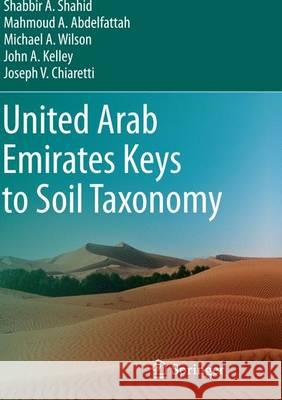United Arab Emirates Keys to Soil Taxonomy » książka



United Arab Emirates Keys to Soil Taxonomy
ISBN-13: 9789402402384 / Angielski / Miękka / 2016 / 108 str.
United Arab Emirates Keys to Soil Taxonomy
ISBN-13: 9789402402384 / Angielski / Miękka / 2016 / 108 str.
(netto: 358,25 VAT: 5%)
Najniższa cena z 30 dni: 360,27
ok. 22 dni roboczych.
Darmowa dostawa!
Chapter 1 Soil Classification
1.1 Introduction
Chapter 2 The Soils That We Classify
2.1 Introduction
2.2 Buried Soils
2.3 Approach to Soil Classification
2.4 Naming Subgroups
Chapter 3 Horizons, Layers, and Characteristics Diagnostic for the Higher Categories
3.1 Introduction
3.2 Master Horizons and Layers
3.3 Suffix Symbols
3.4 Conventions for Using Letter Suffixes
3.5 Vertical Subdivisions
3.6 Discontinuities
3.7 Use of the Prime Symbol
3.8Use of the Caret Symbol.
3.9 Diagnostic Surface Horizons.
3.9.1 The Epipedon
3.9.1.1 Ochric Epipedon
3.10 Diagnostic Subsurface Horizons
3.10.1 Anhydritic Horizon
3.10.2 Calcic Horizon
3.10.3 Cambic Horizon
3.10.4 Gypsic Horizon
3.10.5 Petrocalcic Horizon
3.10.6 Petrogypsic Horizon
3.10.7 Salic Horizon.
3.11 Horizons and Characteristics-Diagnostics of Mineral Soils
3.11.1 Aquic Conditions
3.11.2 Lithic Contact
3.11.3 Paralithic Contact
3.11.4 Paralithic materials
3.11.5 Soil Moisture Regimes
3.11.5.1 Classes of Soil Moisture Regimes
3.11.6 Soil Temperature Regime
Chapter 4 Family and Series Differentiae
4.1 Introduction
4.2 Definition of Particle-Size Classes
4.2.1 Control Section for Particle-Size Classes
4.2.1.1 Root-Limiting Layers
4.2.1.2 Key to Control Section for Particle-Size Classes
4.2.1.3 Key to the Particle-Size Classes.
4.2.2 Strongly Contrasting Particle Size Classes
4.3 Mineralogy Classes
4.3.1 Control Section for Mineralogy Classes
4.3.2 Key to Mineralogy Classes
4.4 Cation-Exchange Activity Classes
4.4.1 Control Section for Cation-Exchange Activity Classes
4.4.2 Key to Cation-Exchange Activity Classes
4.5 Soil Temperature Classes
4.5.1 Control Section for Soil Temperature
4.6 Soil Depth Classes.
4.6.1 Key to Soil Depth Classes
4.7 Phases of Soil Taxa
4.7.1 Key to Phases
Chapter 5 Identification of the Taxonomic Class of a Soil
5.1 Introduction.
5.2 Key to Soil Orders
5.3 Key to Suborders of Aridisols
5.3.1 Calcids.
5.3.1.1 Haplocalcids
5.3.1.2 Petrocalcids
5.3.2 Cambids
5.3.2.1 Haplocambids
5.3.3 Gypsids
5.3.3.1 Calcigypsids
5.3.3.2 Haplogypsids
5.3.3.3 Petrogypsids
5.3.4 Salids
5.3.4.1 Aquisalids
5.3.4.2 Haplosalids
5.4 Key to the Suborders of Entisols
5.4.1 Aquents.
5.4.1.1 Psammaquents
5.4.2 Orthents
5.4.2.1 Torriorthents
5.4.3 Psamments
5.4.3.1 Torripsamments
Chapter 6 Laboratory Methods for Classification of United Arab Emirates Soils
6.1 Introduction
6.1.1 Soil texture
6.1.2 Fragments in the soil
6.1.3 Moisture content
6.1.4 Total pretreatment loss (TPL)
6.1.5 Loss on acid treatment (LAT)
6.1.6 Carbonate equivalents
6.1.7 Gypsum
6.1.8 Anhydrite.
6.1.9 Extractable cations
6.1.10 Cation-exchange-capacity (CEC)
6.1.11 Exchangeable sodium percentage (ESP)
6.1.12 Saturation percentage (SP)
6.1.13 Saturation extract analysis
6.1.14 Electrical conductivity of the saturated extract (ECe)
6.1.15 Soil reaction or hydrogen ion activity (pH)
6.1.16 Sodium adsorption ratio (SAR)
6.1.17 Osmotic potential (OP)
6.1.18 Engineering data
6.1.19 Atterberg limits
6.1.20 AASHTO group classification
6.1.21 Unified Soil Classification System (USCS)
6.1.22 Percent passing sieves
6.1.23 Water retention (WR)
6.1.24 Water retention difference (WRD)
6.1.25 Bulk density (BD)
6.1.26 Particle density (PD)
6.1.27 Porosity.
6.1.28 Organic carbon (OC)
6.1.29 Soil mineralogy (XRD analysis).
6.1.30 Clay mineralogy (CM)
6.1.31 X-ray fluorescence (XRF)
6.1.32 Thin section study (soil micromorphology)
Chapter 7 Soil Families and Soil Series of the United Arab Emirates
7.1 Introduction
Subject Index
Central to human life and civilization, soils are an integral part of the physical and cultural environment. Although we may take them for granted, the rise and fall of civilizations is closely linked with the use and abuse of soil and water resources. It is therefore important to evaluate soils for their quality and link them to appropriate uses and services. This book provides information on soil classification and shows how to key out taxa relevant to UAE soils. The latest soil inventory of United Arab Emirates reveals that a rather uniform looking desert landscape has, in fact, a diversity of subsurface features. These features confirm the soil diversity in terms of classification, chemistry, physics, mineralogy, fertility, suitability for different uses and vulnerability to land degradation. United Arab Emirates Keys to Soil Taxonomy presents information for keying out the soils of the United Arab Emirates into separate classes and provides a guide to associated laboratory methods. The classification used predominantly is extracted from the 11th edition of the USDA-NRCS Keys to Soil Taxonomy, and sections relevant to the soils found in the UAE are included here. Primarily, this key is designed to fit the soil system of the United Arab Emirates. Information not found in the USDA key has been added, including criteria and classes for: 1) differentiating anhydritic soils from gypsic soils, 2) identifying “lithic” subgroups for Aquisalids and Haplosalids, 3) identifying “salidic” subgroups within the great groups of Gypsids, Calcids, Psamments, and Orthents, and 4) incorporation of phases for soil taxa. A subsurface diagnostic horizon and mineralogy class (anhydritic), not reported earlier in the world soil literature and, recently found in the UAE, has also been added to the book. The book also offers a mechanism for updating the current soil surveys, and will facilitate the correlation of soils from new surveys in the UAE. Additionally, it will help the international soil science community to converse about UAE soils, and facilitate comparison to soils of other regions. These linkages allow countries with similar mapping and classification procedures and similar soils to transfer agriculture technology without conducting long-term experiments under similar environmental conditions, especially for Gulf Cooperation Council countries (Bahrain, Kuwait, Qatar, Oman, and Saudi Arabia).
1997-2026 DolnySlask.com Agencja Internetowa
KrainaKsiazek.PL - Księgarnia Internetowa









